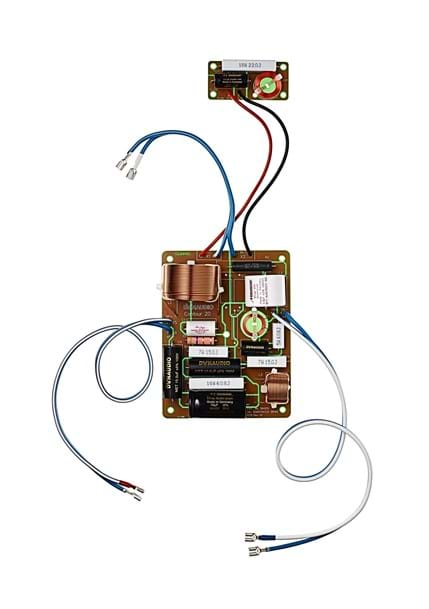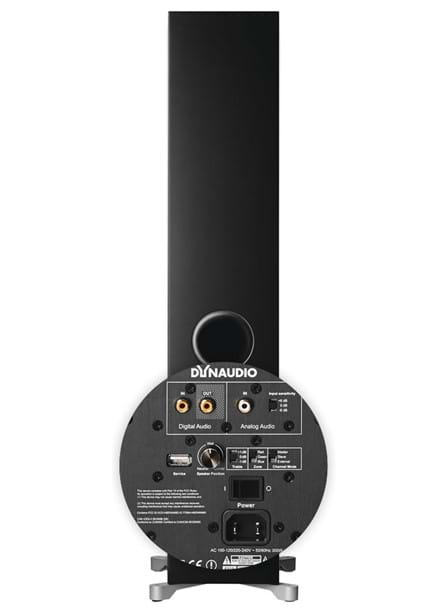As some might know, there are fundamentally two types of crossovers: passive and active ones (Okay, okay, you got me. There are also rare cases of no crossover for speakers with only one drive unit).
And crossovers are pretty darn important in a loudspeaker. They divide frequencies and make sure to send them to the right drive unit: highs for the tweeter, mids for the mid, and lows for the bass. Without them, the frequencies would end up all the wrong places. Say goodbye to that brand-new tweeter of yours.
The difference between passive and active crossovers
In a traditional passive loudspeaker, it would receive a full range signal from an external amplifier for the crossover to split and send to the right drive unit:
“In the conventional system, the crossover is actually a filter network that consists of resistors, coils, and capacitors. Everything was done in the analogue domain,” explains Roland Hoffmann, Senior Manager at the Dynaudio Academy.
However, with active crossovers that process is turned upside down according to him:
“The frequency split is done before amplification with active crossovers. Either in the analogue or digital domain. After the split, the frequencies are sent to individual amplifiers running their own individual drive units.”
But that’s not all; when doing the frequency split in the digital domain it is also possible to keep the music signal in its original digital domain much longer. The frequencies are split digitally by advanced digital signal processing (DSP) and sent to their dedicated power amplifier.
According to Roland that has its benefits: “It’s more accurate to do the frequency split in the digital domain – it’s all zeroes and ones. You don’t lose or change any information from the wear and tear of analogue components.”

A match made in heaven
Now you might think: “Okay, but what are the benefits exactly?” Let’s start with amplification post-split: “With external amplifiers, the developers don’t know what amplifier and speaker will go together,” says Roland. “However, with active crossovers, we can specify the amplifiers to perfectly match our drive units making sure they work together holistically. Because we know both parts.”
And there’s more, as Roland has already touched upon: “You don’t lose or change any information, which happens even when using best analogue components.”
Yes, there’s more control over the process in the digital active crossover; component tolerances are not an issue: “We have much more control over the process and transmission. There are not any component tolerances to worry about. In digital crossovers, the components are numbers in a DSP,” said Jan Abildgaard Pedersen, Chief Technology Officer at Dynaudio, in our Ask the Expert episode about DSP.
That means we can prevent loss of information in the signal path from the source to the drive unit. And that’s important if your goal is to reproduce music as close to the original as possible.
A plethora of opportunity
Finally, digital active crossovers afford a plethora of opportunity as Jan explains: “DSP can do things traditional technology simply cannot. We can’t change the power input at different frequencies in analogue crossovers without altering the phase of the speaker – which will be different at different frequencies.”
But what does phase have to do with anything? Well, if you were to record a male and female voice singing simultaneously and play them back through a speaker with phase issues, then one of the voices would be delayed due to their different frequencies.
You don’t have that restriction with DSP: “We can make what is called a linear-phase filter that introduces a constant time delay at all frequencies in DSP. That would delay all frequencies 20ms and wouldn’t be noticeable. But a time delay between frequencies. Now that’s something you would notice,” Jan finishes.
Choosing the system that suits you
That’s a lot more benefits than only convenience. There’s no doubt that active crossovers present a lot of rational arguments for why you should swing in their direction the next time you look for new speakers: especially if you want to keep the signal as pure as possible.
However, as with all things in life, there are also drawbacks for speakers with active crossovers. The most pronounced one: all of the decisions have been made for you. You can’t upgrade or tweak its amplification like you can with the conventional passive system.
As Roland says: “Upgrading and tweaking gear is part of the hobby, the passion for many audiophiles. So, if you love the sound of a Class A or tube amplifier you might want to consider sticking with passives for the time being.” In the end, it’s all about choosing the system that lets you enjoy your music the best.

The Focus XD series, and Xeo loudspeakers, use advanced active crossovers and Digital Signal Processing.
Sign up to get more great articles
Nothing compares to the satisfaction of knowing – for a fact – that something is as good as it gets





